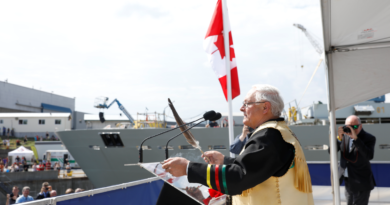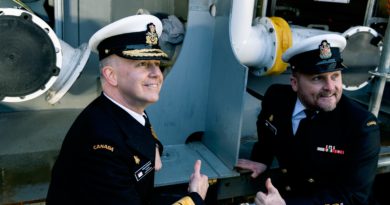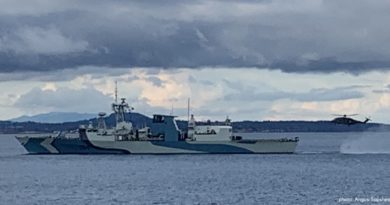CUTLASS FURY – Navies Exercise Off Canada’s East Coast
There has been extensive coverage in traditional and social media about CUTLASS FURY 2016, nickname for the Royal Canadian Navy’s major multi-national exercise now occurring off the Canadian east coast. The coverage is appropriate and good to note, as assuredly one of the objectives of the exercise is to send a message to allies and potential adversaries that the Royal Canadian Navy (RCN) is capable at and willing to undertake difficult large area, open seas naval operations. This is “strategic communications,” a form of activity intensively practiced by militaries, nations, organizations, and others, these days.
In the cryptic language of the military (necessary, considering the challenges of information transmission to and from sea), CUTLASS FURY 2016 is often written as CF 16. Some thoughts arise, and occasionally wander, in reading the various news releases and media reports about CF 16.
CF 16 is the inaugural of what will be a series of similar exercises conducted every two years. That’s not to say that the RCN has not done this sort of exercise before. The RCN has long conducted major multi-national, multi-threat exercises, known variously as MARCOT (Maritime Coordinated Operational Training), SQUADEX (Squadron Exercise), FLTEX (Fleet Exercise) and other names, with forces of our allies coming to the North West Atlantic to practice their capabilities in the demanding maritime environment here. What is interesting to note is the revival of a level of training that was routine during the Cold War in the face of the Soviet threat. CF 16 says something about how the Canadian Armed Forces (CAF) and other militaries view the current global situation. Naval action is no longer just about anti-terrorism, humanitarian assistance/disaster response (HA/DR), and the conduct of maritime intercept operations. Those are still there as areas to exercise, but with a return to practicing what some may call classic naval warfare the end result is even more demand on the men and women, ships and aircraft, logistics and communications of the RCN and Royal Canadian Air Force (RCAF). CF 18 and later will build on CF 16, necessarily so, and keep our Forces in the upper tiers of capability.
It has to be noted that CF 16 is Canadian-led and not a NATO exercise (though participants are all members of that alliance). There are no NATO headquarters, no NATO flags flying, possibly no NATO funding (though some NATO infrastructure is probably being used), and no NATO dignitaries visiting. CF 16 is part of what the CAF calls “force generation” by which the RCN, Canadian Army and RCAF train individuals, teams, units and up to formations (groups) in the skills and knowledge they need to be “combat ready” (which encompasses non-combat capabilities, too). Maritime Forces Atlantic (MARLANT), the RCN formation on the east coast, is responsible for CF 16; there are similar exercises on the west coast led by Maritime Forces Pacific (MARPAC). When necessary, the trained forces will be employed (“force employment”), either domestically in Canada or deployed, by the Canadian Joint Operations Command (CJOC), a senior headquarters in Ottawa. For naval forces, the Commander of MARLANT assumes a different responsibility (“puts on another hat”) and as Maritime Component Commander, controls their activities for CJOC. That control is mid-level (“operational”) – a tactical commander controls local activities. For CF 16, one can be assured that commanders and staffs at the operational and tactical levels are getting exercised too – it is not just the ships and aircraft.
CF 16 is focused on anti-submarine warfare (ASW), operations by sea, air and undersea forces against others’ submarines. ASW, especially in our regional waters, is extremely demanding on everyone from individual sonar operators to collaborating ships, aircraft and sensors operating across the entire area. ASW skills and knowledge are perishable, so must be kept sharp through frequent practice. Like building ships (and Canada has gone through that experience), it is not something to stop and start fitfully. One has to invest, to practice, constantly.
Whilst ASW dominates as an exercise objective, there is other training ongoing. Mine warfare (MW) is being exercised at the entrance of Halifax harbour. MW is another demanding skill and knowledge set – hmm, there’s a theme showing here. The Naval Reserve are a major part of Canada’s MW capability, sailing Kingston-class ships. This emphasizes that being a balanced navy means also having smaller ships and specialized groups like dive teams. At some point the Kingstons will need replacing, as will the small vessels of the Fleet Diving Units. Defence procurement is not just all about acquiring large combatants, replenishment oilers and Arctic patrol ships.
Having a diesel submarine, Her Majesty’s Canadian Ship Windsor, for the exercise is extremely valuable. Though ultimately submarines are strategic assets for countries like Canada, and confound non-friendly states and enemies who might otherwise consider operating submerged in our regional waters, submarines are also great training aids. The availability of a diesel submarine attracts allies to send their forces to exercise with us, which improves the quality of our training. This attraction is especially so when our allies do not have their own diesel submarines, just nuclear-powered ones. Detecting and localizing a diesel submarine is a major accomplishment for any ship, aircraft or ‘nuc’ sub. There will be many failures in the attempt during CF 16.
Amphibious operations briefly showed in early reporting as an exercise objective but apparently was not included in the actual exercise. The fact that it was even considered is significant. The CAF and the RCN have been at the edge of this capability for a while, with a recent course at the Maritime Warfare Centre showing the Navy’s interest in getting smarter about it. There is history with amphibious ops for the RCN but not a major capability at present. To develop it is going to cost. The US Marines will tell us – it takes a lot of effort, even if what the RCN ends up doing is more along the line of ‘sealift’ for HA/DR then ‘Pacific War’ landing assaults. Keep an eye on this.
Whilst assuredly air, surface and underwater drones are being employed in CF 16 as targets, apparently there are no advanced drones in the exercise to conduct surveillance and simulated attacks. Acquisition and use of advanced drones by the RCN and RCAF is essential. The future of operations at sea will be a mix of manned and unmanned platforms. Our allies are already conducting exercises focused on drone employment. Hopefully future CF exercises will see much greater participation by Canadian and allied drones.
And lastly, the name CUTLASS FURY is interesting. It has a nautical flavour, and ‘Fury’ relates it to TRIDENT FURY, a major MARPAC exercise. Probably planning staff came up with CUTLASS FURY to make that connection; certainly it serves as part of strategic communications. Exercises are supposed to have two word nicknames, and there is not the same discipline to have a bilingual name (exercises by Quebec-based units often have French names) as there is in naming operations. That is why operations, distinguished by a one word nickname, often have a Greek word. It is great whenever Inuit words are used for Northern and Arctic operations and exercises. Canada is rich in First Nations, and it would be good to see more use of their words rather than a foreign ones.
It is often said that the value of an exercise is as much in the planning and post-exercise analysis as it is in the actual practice. Assuredly CUTLASS FURY 2016 is a major achievement for the RCN and others of the Canadian Armed Forces. Canadians have a right to be proud of our Navy.




